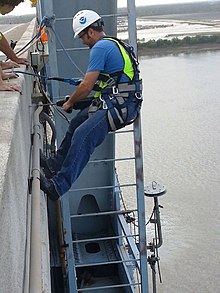This is an old revision of this page, as edited by LetterOpener (talk | contribs) at 02:17, 5 June 2020 (Added links for American National Standards Institute, CSA Group (formerly known as the Canadian Standards Association), added Failed Verification tag for edgefallprotection.com, which is useful but I cannot find the link to the four classes of safety equipment). The present address (URL) is a permanent link to this revision, which may differ significantly from the current revision.
Revision as of 02:17, 5 June 2020 by LetterOpener (talk | contribs) (Added links for American National Standards Institute, CSA Group (formerly known as the Canadian Standards Association), added Failed Verification tag for edgefallprotection.com, which is useful but I cannot find the link to the four classes of safety equipment)(diff) ← Previous revision | Latest revision (diff) | Newer revision → (diff) Equipment designed to protect from falling
A safety harness is a form of protective equipment designed to protect a person, animal, or object from injury or damage. The harness is an attachment between a stationary and non-stationary object and is usually fabricated from rope, cable or webbing and locking hardware. Some safety harnesses are used in combination with a shock absorber, which is used to regulate deceleration when the end of the rope is reached. One example would be bungee jumping.
In North America, safety harness for protection against falls from heights in industrial and construction activities are covered by design performance standards issued by ANSI (American National Standards Institute) in the United States and by CSA Group (formerly known as the Canadian Standards Association) in Canada. Specifically, the standards issued are ANSI Z359.1 and CSA Z259.10. These standards are updated approximately every four to five years so it is important to ensure the latest version is referenced.
Classifications
Fall Protection Systems
Listed below are different types of fall safety equipment and their recommended usage.
Class 1 Body belts (single or double D-ring) are designed to restrain a person in a hazardous work position to prevent fall or to arrest a fall completely within 3 foot of movement (OSHA). Amends must be made to keep the line rigid at all times. A harness should also be used.
Class 2 Chest harnesses are used when there are only limited fall hazards (no vertical free fall hazard), or for retrieving persons such as removal of persons from a tank or a bin.
Class 3 Full body harnesses are designed to arrest the most severe free falls.
Class 4 Suspension belts are independent work supports used to suspend a worker, such as boatswain's chairs or raising or lowering harnesses .
Types
Safety harness types include:
- Seat belts.
- Child safety seats.
- Over-the-shoulder restraints used on roller coaster trains.
- A seat with a full-body harness such as used by fighter pilots.
- Diving harnesses as used by professional divers
Uses
Occupations that may involve the use of safety harnesses include:
- Window cleaner
- Theatrical fly crew member
- Construction worker
- Crane operator
- Bridge painter
- Lineman
- Rock climber
- Motorsport
- Scaffolder
- Sailing
- High ropes
- Bungee jumping
- Professional diver
See also
- Jackstay – Substantial line between two points used to guide or support
- Fall arrest – Equipment which safely stops a person already falling
- Lifeline (diving) – A rope connecting the diver to an attendant, usually at the surface
- Climbing harness
References
- Encyclopedia.com
- "fall protection". Friday, 4 January 2019
- "Fall Protection Information". Archived from the original on 2016-08-04. Retrieved 2017-03-17.
- "bestcarseatbooster.com". Tuesday, 4 July 2017
Jones & Bartlett. Fire Fighter Skills. 2nd ed. Boston, Toronto, London, Singapore: Jones and Bartlett Publishers, 2009. pp243–244. Print.
External links
This technology-related article is a stub. You can help Misplaced Pages by expanding it. |